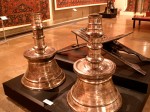Istanbul’s Museum of Turkish and Islamic Art
This morning Darrin Hodgetts joined us for breakfast, and, leaving Ngahuia to an easy morning, we went off for a quick look at an Istanbul Museum, one just around the corner from our Perula Hotel and opposite the Blue Mosque. The museum is situated in what was a palace occupied by ….
The killim work is fantastic and centuries old. What’s so fascinating is the technique…just like taniko, with a whitu twist. And, of course, because they use these items as carpets, they are huge. Indeed, the time commitment on the part of the weaver is more that significant. And just like most women’s arts, really under priced. The other items I was so taken with were the candle holders and oil burners, all sizes. Some really minute, perhaps for sneaking around in the dark. Others, almost as tall as me usually made of brass or silver or stone. And of course, these latter holders were designed to light great cavernous spaces, rooms with ceilings stories high. One last ‘object’ was a door to a place a learning, part of a mosque complex, wood panelling, adorned with copper and bronze plating, all geometrically aligned, perfect math, And the door knockers were huge, impressive, intimidating. I’m of the mind that the MPRU should have one of these! More about the museum below.
Istanbul‘s Museum of Turkish and Islamic Art (Türk-Islam Eserleri Müzesi), on the Hippodrome across from the Blue Mosque (map), is a treasure-house of beautiful objects from the Ottoman (14th to 20th centuries), Seljuk (11th to 13th centuries), and earlier periods beginning in the 8th century.
The museum is housed in the restored Palace of Ibrahim Pasha, a sumptuous residence built by Sultan Süleyman the Magnificent‘s Grand Vezir (and intimate friend) Ibrahim Pasha (served 1523-1536). What you see is only part of the original structure, whose foundations date from about 1500.
Ibrahim Pasha was such a close friend and confidant of Süleyman’s, and had such influence over the monarch, that the sultan’s wife, Roxelana (Hürrem) was worried. When Ibrahim supported the candidacy of Prince Mustafa to be successor to the throne, rather than that of Roxelana’s son Selim, Roxelana acted.
She denounced Ibrahim to the sultan as a traitor, and on the night of March 14, 1536, after dining with the sultan in Topkapi Palace, Ibrahim was strangled, and all his wealth seized by the imperial government.
One of Ibrahim’s mistakes was in living in a palace and a style that rivaled that of his sovereign. Rüstem Pasha, his successor, did not make the same mistake.





